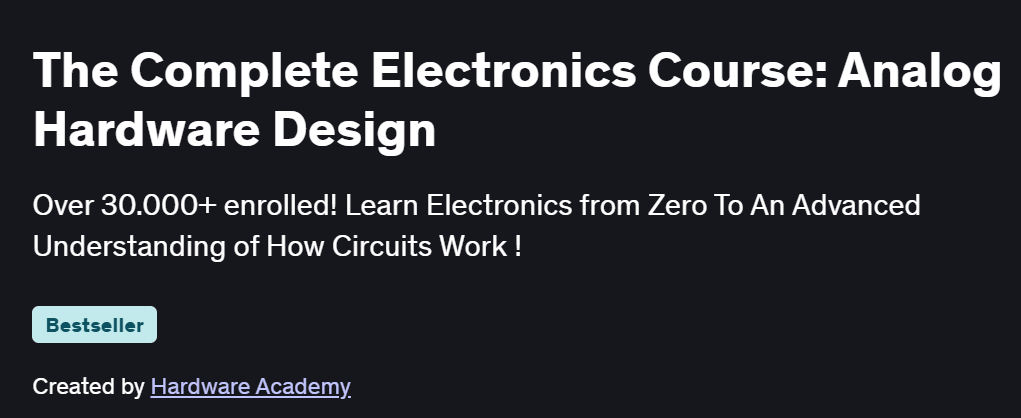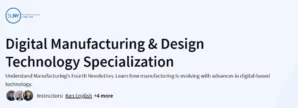What will you in The Complete Electronics Course: Analog Hardware Design Course
Understand fundamental analog components: resistors, capacitors, inductors, diodes, and transistors
Analyze and design basic circuits: voltage dividers, filters, amplifiers, and bias networks
Use SPICE simulation tools to model and verify circuit behavior
Learn PCB prototyping essentials: layout guidelines, grounding, and signal integrity
Troubleshoot real-world analog hardware issues using measurement tools
Program Overview
Introduction to Analog Hardware & Tools
⏳ 30 minutes
Overview of analog vs. digital design and essential lab equipment
Installing and configuring SPICE simulation software
Basic Circuit Laws & Passive Components
⏳ 45 minutes
Ohm’s Law, Kirchhoff’s laws, and resistor networks
Capacitor and inductor behavior in DC and AC circuits
RC & RL Filters
⏳ 1 hour
Designing low-pass, high-pass, and band-pass RC filters
Analyzing transient response of RC and RL circuits
Diodes & Rectifier Circuits
⏳ 45 minutes
Diode I–V characteristics and clipping/clamping circuits
Single- and full-wave rectifier design with smoothing capacitors
Bipolar Junction Transistors (BJTs)
⏳ 1 hour
BJT operating regions, biasing methods, and small-signal models
Designing common-emitter amplifier stages
Metal–Oxide–Semiconductor FETs (MOSFETs)
⏳ 45 minutes
MOSFET characteristics, biasing, and basic amplifier configurations
Comparison of BJT vs. MOSFET for analog design
Operational Amplifier Fundamentals
⏳ 1 hour
Ideal op-amp assumptions, inverting/non-inverting topologies
Designing summing, difference, and active filter circuits
PCB Layout & Prototyping Tips
⏳ 30 minutes
Best practices for analog PCB layout, grounding, and decoupling
Using simple PCB fabrication services and soldering techniques
Get certificate
Job Outlook
- Analog circuit design skills are in demand in consumer electronics, instrumentation, and automotive industries
- Roles include Hardware Engineer, Analog IC Designer, and Test Engineer
- Essential for careers in R&D, prototyping, and embedded systems development
- Foundation for advanced study in RF design, power electronics, and mixed-signal ASICs
Specification: The Complete Electronics Course: Analog Hardware Design
|
FAQs
- No prior electronics background is required.
- Basic math and science knowledge is helpful.
- Core concepts like Ohm’s law are explained step by step.
- Simulations make it easy to visualize circuits.
- The course is designed to guide absolute beginners.
- A free SPICE simulator (LTSpice or similar) is recommended.
- Breadboard, wires, and basic components enhance practice.
- A multimeter helps with measurements and troubleshooting.
- PCB prototyping kits are optional but useful.
- The course shows affordable ways to set up a home lab.
- Teaches practical analog circuit design methods.
- Covers filters, amplifiers, and power circuits.
- PCB layout tips improve real-world reliability.
- Simulation skills save time before building hardware.
- Builds confidence for R&D and prototyping roles.
- Yes, it builds a strong base in analog design.
- Provides background for RF and power electronics.
- Prepares learners for mixed-signal IC design study.
- Useful before diving into embedded systems.
- Opens pathways for advanced university or online programs.
- Hardware Engineer or Test Engineer roles become accessible.
- Useful for prototyping in startups or research labs.
- Electronics skills apply to consumer and automotive industries.
- Enhances embedded systems and IoT hardware careers.
- Provides credibility for freelance circuit design work.





